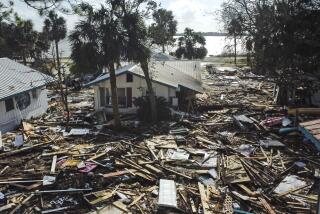Residents Along Gulf Coast Flee Ahead of Lili
- Share via
LAFAYETTE, La. — As one of the worst hurricanes this region has seen in years bore down on the Louisiana coast Wednesday night, hundreds of thousands of frantic residents fled inland, grabbed all the bottled water they could haul and hunkered down behind makeshift wind barriers of plywood and tape.
As the first rainy tendrils of Hurricane Lili pushed toward these swamplands, traffic inched slowly north on back roads. Parishes scrambled to set up shelters for the coastal refugees. Gov. Mike Foster declared a state of emergency, and dozens of mayors along the Gulf of Mexico readied their towns for the worst.
“We have a real disaster in the making,” said Max Mayfield, director of the National Hurricane Center in Miami. “This is going to be the worst hurricane to hit the Louisiana coast since reconnaissance data has been available in the 1940s.”
The Category 4 storm was expected to blast the Gulf Coast this morning with tidal surges, shearing winds and powerful rains. As a fierce Lili roared in off the Gulf, residents of a swath of shoreline from Port Arthur, Texas, in the west to the Mississippi River in the east scrambled for shelter.
By nightfall, Lafayette stood eerily quiet. Hotels were sold out as many sought refuge in the more solidly constructed buildings. Convenience stores were abandoned. Even the Wal-Mart--that perennial, all-night, American harbor--closed its doors at 8 p.m. Damp streets stood empty, and the air was ominously heavy.
“This is going to be bad, maybe as bad as the hurricanes that all the old people still talk about,” said Mike Barry, glancing around the lobby of a sold-out hotel here. Weary-eyed families wandered in out of the night, everything from diapers to electric fans in tow.
Entire counties were evacuated along the coastlines from the Mississippi border to the oil patch towns of East Texas. By dusk, hamlets, prisons, factories, farms, ports and offshore oil and gas rigs were drained of their inhabitants.
At Louisiana’s Avery Island, home of Tabasco hot pepper sauce, the McIlhenny Co. shut its lone bottling plant.
“We’ll be closed as long as it takes to get our power back and let our people clean out their homes,” Executive Vice President Tony Simmons said. But he said hot-sauce lovers need not worry: “We’re not anticipating anyone running out of Tabasco.”
While wary residents fled north, authorities sent sandbags, generators, emergency supplies and doctors to the south and braced for a rare October hurricane in a region that has been mostly spared so far this season.
Workers throughout southern Louisiana were rushing to finish repairs on levees and storm drains damaged last week by Tropical Storm Isidore, which flooded hundreds of homes and caused about $100 million in damage there.
“We believe we’ve done everything we can to prepare, and, fortunately or unfortunately, we had Isidore last week for practice,” said Janet Faulk, chief administrative officer in New Iberia, a city of 33,000 that sat dead center in Lili’s potential path Wednesday night.
The threat to low-lying towns such as New Iberia was obvious. The highest point is 24 feet above sea level--and Lili threatens to come ashore with 20-foot storm surges. “All we can do now is sit tight,” Faulk said.
Lili was a mere Category 2 late Tuesday when it headed north from Cuba and out of the Caribbean, where the storm left eight people dead and forced thousands of Cubans from their homes. The National Weather Service reported Lili’s sustained winds at 145 mph Wednesday and the storm was upgraded on the Saffir-Simpson scale, which sets Category 5 as the most severe. Hurricane hunter aircraft reported gusts as great as 150 mph near the eye late Wednesday, and the weather service said further strengthening of the storm was possible before landfall today.
As Lili quickly grew in strength Wednesday from the warm Gulf waters, NASA officials postponed the space shuttle Atlantis’ launch at Cape Canaveral, Fla., concerned that Lili’s inland winds and rain could knock out communications at Johnson Space Center in Houston.
One computer projection of the storm’s course showed Lili striking the upper Texas coast, which could send 50-mph winds into the Houston area. That would shut down mission control, which would prevent three planned spacewalks by Atlantis’ astronauts at the International Space Station, a NASA spokesman said.
The delay marked the first time that Texas weather canceled a Florida launch, which has been tentatively reset for Monday.
Houston, which basked in humid sunshine Wednesday, took few precautions before the storm, although Gov. Rick Perry signed a disaster declaration.
The governor’s action paves the way for immediate federal emergency funds if and when the storm hits parts of the state.
Texas’ costliest hurricane was Alicia in 1983, which caused $3 billion in damage in Galveston and Houston. The state’s deadliest storm--a Category 4--killed at least 8,000 people in Galveston in 1900, a time before hurricanes were named.
The most lethal hurricane to hit southwest Louisiana was Audrey in 1957, which killed 526 people and caused $120 million in damage.
*
Stack reported from Lafayette and Fineman from Houston. Times researcher Lianne Hart contributed to this report.
More to Read
Sign up for Essential California
The most important California stories and recommendations in your inbox every morning.
You may occasionally receive promotional content from the Los Angeles Times.













